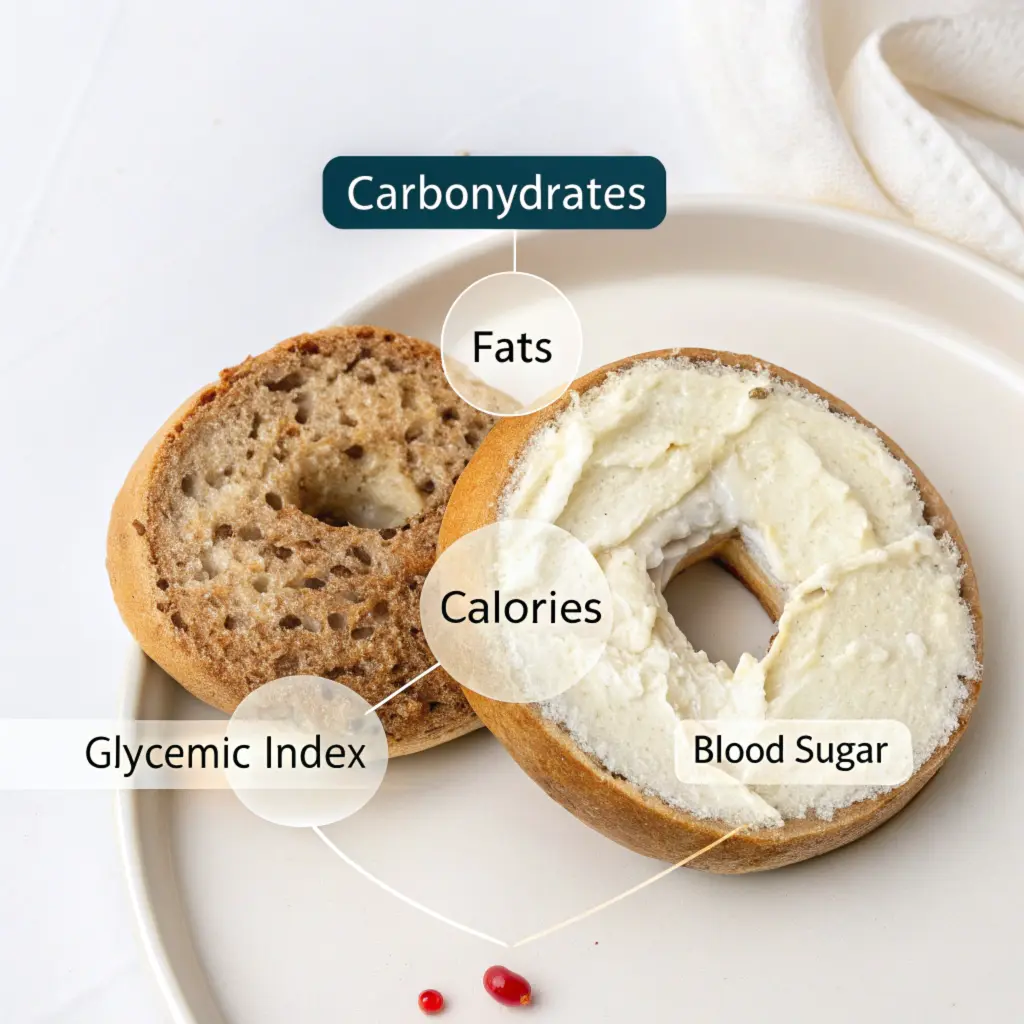Bagels with cream cheese have been a breakfast staple for ages. Their creamy texture paired with the doughy comfort of a bagel is undeniably satisfying. But for people managing diabetes, the question looms: Can diabetics eat bagels and cream cheese safely? This article dives into their nutritional impact, healthier alternatives, and practical tips to keep them in your diet—without spiking blood sugar. Whether you’re a bagel lover or just curious, let’s uncover everything you need to know.
The Role of Nutrition in Managing Diabetes
When living with diabetes, every bite counts. Foods rich in simple carbohydrates or saturated fats can cause blood sugar levels to soar. That’s why understanding what’s on your plate—and how it affects your body—is crucial. The goal isn’t deprivation but making mindful choices that stabilize glucose levels.
Why Are Bagels and Cream Cheese So Popular?
Bagels have long been a beloved breakfast food, often paired with cream cheese for convenience and taste. But here’s the catch: traditional bagels are carbohydrate-heavy, and cream cheese is loaded with saturated fats. For diabetics, this combo may not be the best option unless consumed with a plan. Still, with a few tweaks, they can be enjoyed without guilt or worry.
If you’re intrigued by garlic cream cheese, check out our ultimate recipe and guide for Garlic Cream Cheese Bagels.
Nutritional Profile of Bagels
Bagels are a go-to for a quick and filling breakfast, but for diabetics, it’s essential to understand their nutritional content. A standard bagel might seem harmless, but its carb-heavy nature and glycemic impact can be tricky to manage. Knowing what’s in a bagel—and how it affects blood sugar—is key to making an informed decision.
Carbohydrate Content and Glycemic Index of Bagels

Bagels are primarily made from refined flour, which is a dense source of simple carbohydrates. A single medium bagel contains around 48–60 grams of carbs, which is significant for someone monitoring their daily intake. These carbohydrates break down quickly, causing a rapid spike in blood sugar levels.
The glycemic index (GI) of a plain bagel is relatively high, typically around 70. Foods with a GI over 55 are known to elevate blood sugar levels more quickly. Whole-grain bagels, however, have a lower GI due to their fiber content, which slows down digestion and glucose absorption.
Impact of Bagels on Blood Sugar Levels
Eating a regular bagel without proper pairing—like with protein or healthy fats—can cause a sudden blood sugar spike. This is due to the high glycemic load and the absence of fiber, which plays a critical role in balancing glucose levels.
For diabetics, pairing a bagel with protein (such as eggs or low-fat cream cheese) or fiber-rich vegetables can reduce this glycemic impact. Also, opting for smaller portions or mini bagels is a practical way to enjoy them without going overboard.
Nutritional Profile of Cream Cheese
While cream cheese adds a deliciously smooth texture to bagels, it’s important to consider its nutritional profile. High in fats and calories, it can contribute to daily intake concerns, especially for those managing diabetes or weight.
Fat and Calorie Content in Cream Cheese
Regular cream cheese is rich in saturated fats, with a typical serving (about 2 tablespoons) containing 90–100 calories and around 9 grams of fat. Saturated fats are known to increase insulin resistance if consumed in excess, making blood sugar management even more challenging.
Low-fat or reduced-fat cream cheese options, however, are available and offer a lighter alternative with significantly less fat—sometimes as little as 4 grams per serving. These versions still provide the creamy texture without the heavy calorie load.
Cream Cheese and Its Glycemic Impact
The glycemic index of cream cheese is very low, as it contains negligible carbohydrates. While this is good news for blood sugar stability, the high-fat content can slow digestion when combined with carbohydrate-rich foods like bagels. This delayed digestion could lead to prolonged blood sugar elevation.
For diabetics, balancing cream cheese with toppings like fresh veggies or swapping it for protein-packed alternatives (like Greek yogurt-based spreads) can keep meals satisfying without sacrificing health.
Can Diabetics Eat Bagels and Cream Cheese?
The big question: Can diabetics eat bagels and cream cheese? The answer is both yes and no—it depends on portion sizes, ingredient choices, and overall meal planning. While this classic pairing isn’t off-limits, understanding how it fits into a diabetic-friendly diet is essential for maintaining stable blood sugar levels.
Bagels and cream cheese can quickly become problematic due to their high carbohydrate and fat content. However, with mindful choices, this breakfast staple can still be enjoyed in moderation. Pairing it with low-GI foods and incorporating whole-grain options can help diabetics manage their glucose levels better.
Potential Risks of Consuming Bagels and Cream Cheese
The risks largely stem from the nutritional composition of bagels and cream cheese. Bagels made with refined flour can cause blood sugar spikes due to their high glycemic index and lack of fiber. Cream cheese, though low in carbs, is high in saturated fats, which may contribute to insulin resistance if consumed in large amounts.
Overindulging in this pairing can also lead to excess calorie intake, potentially leading to weight gain—a key factor in worsening diabetes symptoms. Without careful portion control and proper pairing with other foods, bagels and cream cheese can negatively impact blood sugar management.
Benefits of Moderate Consumption
When consumed in moderation and with strategic planning, bagels and cream cheese can be part of a balanced diabetic diet. Whole-grain or low-carb bagels are excellent substitutes for traditional versions. Additionally, opting for reduced-fat or plant-based cream cheese spreads significantly reduces unhealthy fat intake.
The real benefit comes from how you pair them. Adding a side of fiber-rich vegetables, lean proteins, or healthy fats (like avocado) can create a more balanced meal. These additions help slow digestion and prevent drastic blood sugar fluctuations, making it easier to enjoy this comfort food safely.
Selecting Diabetes-Friendly Bagel Options
Choosing the right kind of bagel makes all the difference for diabetics. While traditional bagels are carb-heavy and lack fiber, there are better alternatives that align with a diabetic-friendly diet. For example, whole-grain bagels provide more fiber and nutrients compared to refined versions, making them a healthier option. To learn more about managing a balanced diet with diabetes, visit the CDC’s guide to healthy eating for diabetics.
Whole Grain vs. Refined Bagels
Whole-grain bagels are a smarter option for diabetics compared to their refined counterparts. Whole grains are rich in fiber, which slows digestion and helps stabilize blood sugar levels. They also have a lower glycemic index, reducing the risk of glucose spikes.
Refined bagels, on the other hand, are made from white flour, stripping them of nutrients and fiber. This leads to a faster breakdown of carbohydrates and rapid blood sugar elevation. Whole-grain varieties, such as multigrain or oat-based bagels, offer a heartier texture and greater nutritional benefits. Always check for “100% whole grain” on labels to ensure you’re making the best choice.
Comparison Table: Traditional vs. Diabetes-Friendly Bagels and Cream Cheese
| Category | Traditional Bagel & Cream Cheese | Diabetes-Friendly Alternative |
|---|---|---|
| Bagel Type | Refined white bagel | Whole-grain or low-carb bagel |
| Carbohydrates (per serving) | ~50–60 grams | ~20–30 grams |
| Fiber Content | ~1–2 grams | ~4–6 grams |
| Cream Cheese | Full-fat cream cheese | Low-fat or plant-based cream cheese |
| Calories (per serving) | ~350–450 | ~200–300 |
| Glycemic Index | High (around 70) | Moderate to low (around 50–55) |
Portion Control Strategies
Managing portion sizes is another effective way to enjoy bagels without worrying about blood sugar spikes. Instead of eating a full-sized bagel, opt for a mini bagel or eat just half of a regular one. Pair it with protein or fiber-rich sides to feel satisfied without overindulging.
Additionally, toasting bagels can create the illusion of more volume, helping you feel fuller with a smaller portion. Another trick? Scoop out the soft interior of the bagel to reduce its carb content while still enjoying the flavor and texture.
Healthier Alternatives to Cream Cheese
While cream cheese is a classic choice, there are plenty of healthier options that provide similar creaminess without the saturated fat. Exploring these alternatives can open up new flavors while keeping your meal more diabetes-friendly.
Low-Fat and Plant-Based Spreads

Low-fat cream cheese or reduced-fat spreads are great substitutes for the full-fat version. These products maintain the signature smooth texture with significantly fewer calories and saturated fats.
Plant-based alternatives, such as cashew or almond cream cheese, are excellent for diabetics seeking healthier, dairy-free options. These are typically lower in saturated fat and can include beneficial nutrients like vitamin E and magnesium. Look for unsweetened varieties to avoid hidden sugars.
Incorporating Protein-Rich Toppings
For a heartier, diabetes-friendly topping, consider spreading Greek yogurt mixed with herbs or avocado instead of cream cheese. Greek yogurt is high in protein and lower in fat, making it a satisfying and nutritious choice.
Adding lean protein toppings, such as smoked salmon or boiled egg slices, can further balance your meal. Protein helps stabilize blood sugar levels and keeps you feeling full longer. Incorporating vegetables like cucumber or tomato slices provides added fiber, crunch, and nutrients—without spiking blood sugar.
Balancing Bagels and Cream Cheese in a Diabetic Diet
Bagels and cream cheese can fit into a diabetic-friendly diet with a bit of planning. The key lies in maintaining balance by combining this meal with healthy habits, mindful food pairings, and proper portion sizes. It’s not about giving up favorites but rather enjoying them in a way that aligns with managing blood sugar levels.
Pairing bagels and cream cheese with nutrient-dense foods can mitigate their glycemic impact. For instance, a half whole-grain bagel with low-fat cream cheese, topped with fiber-rich vegetables, can turn a potentially blood sugar-spiking breakfast into a more balanced meal.
Monitoring Blood Sugar Levels Post-Consumption
One essential step after eating bagels and cream cheese is to check your blood sugar levels. For diabetics, it’s crucial to understand how specific foods affect glucose. Testing your levels 1–2 hours after a meal can give insights into how well your body is responding.
This practice not only helps refine portion sizes but also informs food choices for future meals. If you notice significant spikes, consider reducing the serving size or pairing it with additional fiber or protein. Keeping a food journal can also be helpful in tracking patterns and identifying which combinations work best for you.
Integrating Physical Activity to Manage Blood Glucose

Adding some light physical activity after consuming carbohydrate-heavy meals like bagels can help manage glucose levels more effectively. Walking for 15–30 minutes after eating is particularly effective for improving blood sugar regulation.
Exercise stimulates muscle cells to absorb glucose for energy, reducing the burden on insulin. Even mild activities like stretching or a quick household chore can contribute to stabilizing blood sugar. Making physical activity a part of your daily routine not only supports better glucose control but also enhances overall health and energy levels.
Frequently Asked Questions
How many calories in a bagel and cream cheese?
A standard plain bagel with regular cream cheese contains approximately 300–400 calories, depending on the size of the bagel and the amount of cream cheese used. Larger bagels or extra cream cheese can increase the calorie count significantly. Opting for smaller, whole-grain bagels with reduced-fat cream cheese can help lower the overall calorie intake.
For a detailed breakdown of calorie counts for different bagel and cream cheese options, visit our guide on How Many Calories in a Bagel with Cream Cheese.
Is a bagel and cream cheese healthy?
It depends on how it’s prepared. Traditional bagels with full-fat cream cheese are high in refined carbs and saturated fats, which may not align with healthy eating goals, especially for diabetics. However, using whole-grain bagels and low-fat or plant-based spreads can make this pairing a healthier choice.
For more insights into whether bagels and cream cheese can fit into a healthy lifestyle, check out our article on Is Bagel and Cream Cheese Healthy?.
What is good on a bagel with cream cheese?
For added flavor and nutrition, top your bagel and cream cheese with fresh vegetables like cucumbers, tomatoes, or sprouts. Protein-rich toppings, such as smoked salmon or boiled egg slices, are also great options. Avocado or nut-based spreads are tasty alternatives to cream cheese that provide healthy fats and nutrients.
For even more ideas and inspiration, visit our detailed guide on What Is Good on a Bagel with Cream Cheese.
Are bagels and cream cheese suitable for weight loss?
Not typically, as traditional bagels and cream cheese are calorie-dense and lack fiber. However, smaller portions of whole-grain bagels with low-fat or plant-based spreads, combined with fiber-rich vegetables, can fit into a weight-loss plan when consumed mindfully. Balancing this meal with exercise and other low-calorie, nutrient-dense foods is essential.
Final Thoughts on Diabetics Consuming Bagels and Cream Cheese
Bagels and cream cheese can be a part of a diabetic-friendly diet when approached with mindfulness. For those wondering, can diabetics eat bagels and cream cheese, the answer depends on the choices you make. Traditional versions may pose challenges due to their high carbohydrate and fat content. However, making strategic adjustments—like choosing whole-grain bagels, low-fat spreads, and practicing portion control—can reduce their impact on blood sugar levels.
So, can diabetics eat bagels and cream cheese safely? Absolutely, but it’s all about balance. Pairing bagels with protein and fiber-rich toppings, monitoring blood sugar levels post-meal, and incorporating physical activity into your routine can help diabetics enjoy this classic breakfast without worry.
Remember, no single food needs to be completely off-limits. With informed choices and careful planning, can diabetics eat bagels and cream cheese as part of their diet? Yes, they can, when treated as an occasional indulgence rather than a dietary staple.

